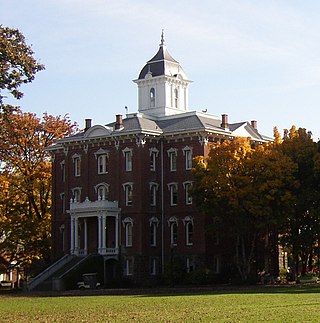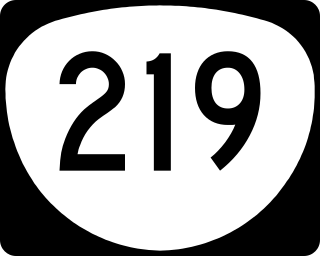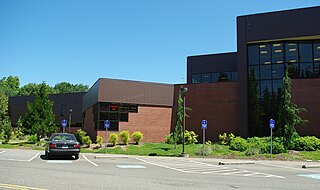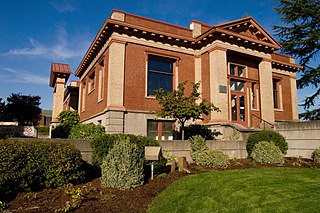
Salem is the capital city of the U.S. state of Oregon, and the county seat of Marion County. It is located in the center of the Willamette Valley alongside the Willamette River, which runs north through the city. The river forms the boundary between Marion and Polk counties, and the city neighborhood of West Salem is in Polk County. Salem was founded in 1842, became the capital of the Oregon Territory in 1851, and was incorporated in 1857.

Yamhill County is one of the 36 counties in the U.S. state of Oregon. As of the 2020 census, the population was 107,722. The county seat is McMinnville. Yamhill County was named after the Yamhelas, members of the Kalapuya Tribe.

Marion County is one of the 36 counties in the U.S. state of Oregon. The population was 345,920 at the 2020 census, making it the 5th most populous county in Oregon. The county seat is Salem, which is also the state capital of Oregon. The county was originally named the Champooick District, after Champoeg, a meeting place on the Willamette River. On September 3, 1849, the territorial legislature renamed it in honor of Francis Marion, a Continental Army general from South Carolina who served in the American Revolutionary War. Marion County is part of the Salem, OR Metropolitan Statistical Area, which is also included in the Portland-Vancouver-Salem, OR-WA Combined Statistical Area. It is located in the Willamette Valley.

Stayton is a city in Marion County, Oregon, United States, located 12 miles (19 km) southeast of the state capital, Salem, on Oregon Route 22. It is south of Sublimity and east of Aumsville. Located on the North Santiam River, Stayton is a regional agricultural and light manufacturing center. The population was 8,244 at the 2020 census. Established in 1872, it was incorporated in 1891. Stayton is part of the Salem Metropolitan Statistical Area.

Woodburn is a city in Marion County, Oregon, United States. Incorporated in 1889, the community had been platted in 1871 after the arrival of the railroad. The city is located in the northern end of the Willamette Valley between Portland and Salem. Interstate 5 connects it to major cities to the north and south. Oregon routes 211, 214, 219, and 99E also serve the city, as do Union Pacific and Willamette Valley Railway freight rail lines.

McMinnville is the county seat of and most populous city in Yamhill County, Oregon, United States at the base of the Oregon Coast Range. The city is named after McMinnville, Tennessee. As of the 2020 census, the city had a population of 34,319.

Sheridan is a city in Yamhill County, Oregon, United States. Platted in the 1860s when it received a post office, the city was incorporated in 1880. A major fire burned much of the city in 1913, and a flood covered much of the city in 1964. The population of the city as of the 2020 Census was 6,233, an increase from 6,127 at the 2010 census.

Willamina is a city in Polk and Yamhill Counties in the U.S. state of Oregon. The population was 2,239 at the 2020 census.

Oregon Route 18 is a state highway that runs between the Oregon Coast, near Lincoln City, and Newberg. OR 18 traverses the Salmon River Highway No. 39 of the Oregon state highway system, named after the river alongside its westernmost segments.

Oregon Route 219 is an Oregon state highway which runs between the cities of Hillsboro and Woodburn, Oregon, in the United States. The Hillsboro-Silverton Highway continues further south to Silverton, signed as OR 214. The highway mainly serves local residents and agricultural traffic, despite its proximity to the Portland area it lies outside the Portland Urban Growth Boundary, and maintains its character as a country road.

Oregon Route 22 is an Oregon state highway that runs between the Oregon Coast community of Hebo, to a junction with U.S. Route 20 near Santiam Pass in the Cascade Mountains. OR 22 traverses several highways of the Oregon state highway system, including the Three Rivers Highway No. 32, part of the Salmon River Highway No. 39, the Willamina–Salem Highway No. 30, part of the Salem Highway No. 72, and the North Santiam Highway No. 162.

Cherriots, officially the Salem Area Mass Transit District, is a public transit operator based in Salem, Oregon, United States. The agency, whose name refers to the city's nickname, provides bus and paratransit service in Salem and neighboring Keizer. It was founded in 1979 as the Salem Area Mass Transit District, replacing municipal and private systems, and renamed itself to Salem-Keizer Transit in 2003. In 2023, the system had a ridership of 3,133,700, or about 19,800 per weekday as of the third quarter of 2024.

Chemeketa Community College is a public community college in Salem, Oregon, with a campus in McMinnville, and education centers in Dallas, Brooks, and Woodburn. In addition, the college has a Center for Business and Industry in downtown Salem that houses the Small Business Development Center. It operates classes and programs benefiting area businesses.
Rail transportation is an important element of the transportation network in the U.S. state of Oregon. Rail transportation has existed in Oregon in some form since 1855, and the state was a pioneer in development of electric railway systems. While the automobile has displaced many uses of rail in the state, rail remains a key means of moving passengers and freight, both within the state and to points beyond its borders.

Newberg Public Library is a public library system that serves the city of Newberg, Oregon, United States serving a population 25,138 as of 2020.

The Salem Public Library is a public library system serving Salem, Oregon, United States. The system includes two branches and is a member of the Chemeketa Cooperative Regional Library Service, which serves the Salem metropolitan area.
Gretchen Susan Schuette is an American academic who is President Emeritus of Chemeketa Community College in the U.S. state of Oregon. She has served at multiple levels of leadership at Linn–Benton Community College and Mt. Hood Community College, and in other roles in higher education: as director, dean and president, as superintendent, as member of the Oregon State Board of Higher Education, and as Oregon's commissioner of community colleges. She has been described as "one of the most highly regarded educators and administrators in the West".

















